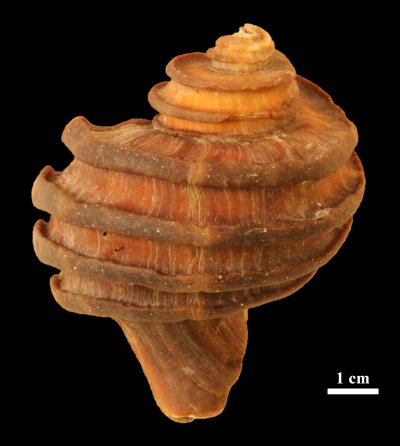
A 15-million year old fossil gastropod, Ecphora, from Calvert Cliffs. The reddish brown color arises from the original shell-binding proteins and pigments preserved in the mineralized shell. Picture courtesy of John Nance.
SOLOMONS, Md. (Feb. 5, 2015)—“Fossil” protein has been discovered in beautifully preserved 15-million-year-old snail shells recently collected along Calvert Cliffs. Known as Ecphora, the fossil shell is Maryland’s state fossil. John Nance, Assistant Curator of Paleontology at the Calvert Marine Museum, is part of the team that made this discovery. “It is one of the most iconic, beautiful, and prized fossils found along the cliffs,” said John Nance.
Nance worked with a team of colleagues that included John Armstrong, George Cody, Marilyn Fogel, and Robert Hazen from the Geophysical Laboratory at the Carnegie Institution of Washington. Their findings are published in the inaugural issue of Geochemical Perspectives Letters.
Ecphora is known for its characteristic reddish-brown shell color, making it one of the most distinctive North American mollusks of its time. It is rare that coloration is preserved in fossilized remains; most of the fossilized mollusks from Calvert Cliffs have turned chalky white over millions of years.
Fossil shells are made from crystalline compounds of calcium carbonate interspersed with an organic matrix of proteins and sugars. These proteins are called shell-binding proteins because they help hold the shell together. They also contain pigments, such as those responsible for the reddish-brown appearance of the Ecphora shell. These pigments bind to proteins to form a pigment-protein complex.
That the coloration of fossilized Ecphora shells is so well preserved suggested to the research team that shell proteins bound to these pigments might also be preserved. They were amazed to find that the shells, once dissolved in dilute acid, released thin sheets of shell proteins more than a centimeter across. Chemical analysis of these sheets revealed that they were 15-million-year-old shell proteins.
Remarkably, the proteins share characteristics with modern mollusk shell proteins. They produce thin, flexible sheets of residue that is the same color as the original shell after being dissolved in acid. Proteins are composed of chains of amino acids. Of the 11 amino acids found in the resulting residue, aspartate and glutamate are prominent, typical of modern shell proteins. Further study of these proteins could be used to trace the evolution of mollusks through the ages, as well as learn about the ecology of the Western Atlantic Ocean when Ecphora thrived.
For copies of the published paper, visit www.geochemicalperspectivesletters.org/article1501
Source: Calvert Marine Museum


